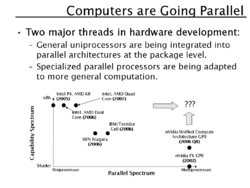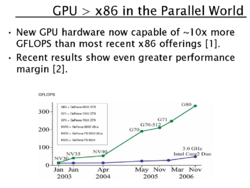GPU.Enabled.Tools.Meeting
Goals
Current trends in processor markets show movement towards highly capable parallel computing (see Fig 1). Spurred on by the computer gaming industry, graphics processing units (GPUs) -- traditionally purely simplistic devices involved in piping pixels to the monitor -- have evolved into very powerful and affordable parallel computing platforms. Companies like nVidia and ATI (recently acquired by AMD) compete to sell their GPUs to video gamers.
The medical image processing community stands to benefit greatly from this trend in the marketplace. The vast majority of medical image processing algorithms are parallelizable (i.e. rather than processing pixels 1-by-1 in a serial manner, operations can be performed simultaneously across the entire image), at least to some degree. Speedups on the order of 50-150x are achievable in this manner.
The purpose of this meeting is to explore the impact of GPU computing on the NA-MIC toolkit. How/when/should we start supporting GPU-based algorithms?
Meeting Attendees
- John Melonakos, Georgia Tech
- Gallagher Pryor, Georgia Tech
- Ron Kikinis, MD
- Ross Whitaker
Suggested Readings
- High-level explanation of GPUs: HowStuffWorks.com.
- Performance charts of commercially available GPUs: [
 | Tom's Harware].
| Tom's Harware]. - See information from 2006 NA-MIC event on GPU programming.
Agenda
TBD

